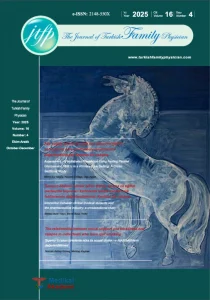The Relationship between death anxiety and rational drug use
Objective: The aim of the study was to evaluate the relationship between death anxiety levels and rational drug use of individuals admitted to Karabuk Community Health Center Smoking Cessation Outpatient Clinic.
Materials and Methods: A correlational and descriptive methodology was used in this study. The study included 278 individuals and the survey method was applied. Data entry was made with SPSS 22. In the study, data on rational drug use and death anxiety levels of individuals were found.
Results: As a result of the study, levels of rational drug use and death anxiety levels in individuals were determined separately. As a result of the evaluation, it was found that rational drug use decreased proportionally as death anxiety level increased. In the study, the value of p<0.05 was considered significant.
Conclusion: According to the results obtained, the mean score of the participants’ death anxiety level is 35.0 ± 9.53 and this score is consistent with overall-moderate death anxiety. The moderate score for the level of rational drug use was found to be 38.9 ± 3.43, indicating that the participants had a level of rational drug use above the average. In conclusion, the study showed that as death anxiety increased, the level of rational drug use decreased.
References
- Quick JD. Management Sciences for Health; In “Managing Drug Supply”. West Hartford, Connecticut, Kumarian Press. 1997.
- Fresle DA, Wolfheim C & WHO Action Programme on Essential Drugs. (1997). Public education in rational drug use: a global survey. World Health Organization. https://apps.who.int/iris/handle/10665/63823 sayfasından 03.11.2020 tarihinde erişilmiştir.
- World Health Organization. (1988). The World drug situation. https://apps.who.int/iris/handle/10665/37781 sayfasından 03.11.2020 tarihinde erişilmiştir.
- World Bank. Better health in Africa: experiences and lessons learned. Washington DC: The World Bank. 1994.
- Ross-Degnan D, Laing R, Santoso B, Afori-Adjei D, Diwan V, Lamoureux C, and Hogerzeil H. Improving pharmaceutical use in primary care in developing countries: A critical review of experience and lack of experience. Paper Prepared For International Conference on Improving Use of Medicines, Chiang. 1997.
- Abacıoğlu N. Akılcı (Rasyonel) ilaç kullanımı. Bilim Eğitim ve Düşünce Dergisi 2005; 5:5(4): 1-7.
- Tillich P. The Courage to Be. Yale University Press, New Haven. 1952.
- Kroshus J, Swarthout D, Tibbetts S. Critical incident stress among funeral directors: Identifying factors relevant for mental health. Journal of Mental Health Counseling 1995; 17: 441-51.
- Holness DL, Nethercott JR. Health Status of Funeral Service Workers Exposed to Formaldehyde. Archives of Environmental Health 1989; 44(7): 222-8.
- Turner SB, Kunches LM, Gordon KF, Travers PH, Mueller NE. Occupational Exposureto Human İmmunodeficiency Virus (HIV) and Hepatitis B Virus (HBV) among embalmers: A pilot seroprevalence study. American Journal of Public Health 1989;79:1425-6.
- Yalom ID. Staring at the sun: Overcoming the Terror of Death. San Francisco, Jossey Bass. 2008;283-97.
- Gilliland JC, Templer D. Relationship of death anxiety scale factors to subjective states. Omega 1986;16:155-67.
- Noyes R, Stuart S, Longley S, Langbehn DR, Happel RL. Hypochondriasis and fear of death. The Journal of Nervous and Mental Disease 2002;190:503–9.
- Stolorow RD. Defensive and arrested developmental aspects of death anxiety, hypochondriasis and depersonalization. The International Journal of Psychoanalysis 1979; 60:201–13.
- Stanley MA, Beck JG. Anxiety Disorders. Clin Psychol Rev 2000;20(6):731-54.
- Kahyaoğlu M, Birel FK, Yetiş Mİ. Ortaokul öğrencilerinin fen bilimleri derslerine yönelik kendi̇ kendine öğrenme becerı̇lerı̇nı̇n yordanmasında kaygının rolü̈. Elektronik Sosyal Bilimler Dergisi 2019;18(69):385-97.
- Tüm DÖ. Öğretmen adaylarının yabancı dil kaygısı. Kastamonu Eğitim Dergisi 2019; 27(3):1359-69.
- Gregersen TS. To err is human: A reminder to teachers of language- anxious students. Foreign Language Annals 2003;36 (1):25-32.
- Özgür G, Yıldırım S, Aktaş N. Bir üniversite hastanesinin ameliyathane ve yoğun bakım hemşirelerinde ruhsal durum değerlendirmesi. Cumhuriyet Üniversitesi Hemşirelik Yüksekokulu Dergisi 2008;12:21-30.



